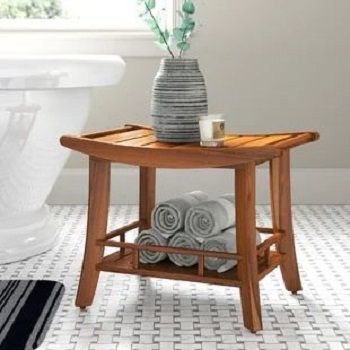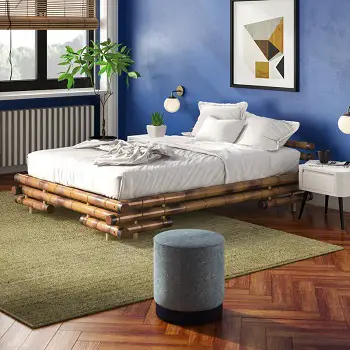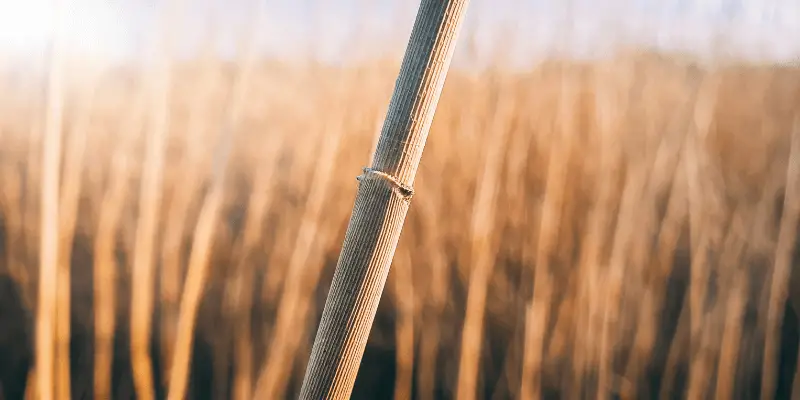aAt first glance, it’s easy to confuse bamboo for a tree. It’s tall, green, and has a wood-like feel to it. You might be surprised to find out that bamboo is grass, not a tree.
Bamboos are considered grass as they are a diverse group of perennial flowering plants. They are evergreen and are classified in the Bambusoideae subfamily of the grass family Poaceae. Bamboos are the tallest and most prominent of all other grasses.
Even though Bamboo is grass and not a tree, many bamboos become exceptionally tall and have a tree-like appearance. They are often referred to as “Bamboo Trees”. However, grasses and trees have quite several essential differences.
A common reason why bamboo is mistaken for wood is due to the variety of traditional wooden products now manufactured from bamboo.
Common wooden furniture such as tables, chairs, and beds are now being made from bamboo grass.
Kitchen accessories like chopsticks, bowls, spoons are also made from bamboo. The same applies to home décor like bamboo floors have a similar appearance to hardwood floors.
Browse our catalog of all the best bamboo furniture and bamboo home décor here!
What Makes Bamboo Grass?
Poaceae Family: The Poaceae family grass plants. In this family, most grasses are bamboos, cereals grasses, natural grassland grasses, lawns, and cultivated pastures.
Culms: Culms are the stems of the grasses and usually are cylindrical and hollow, except for a few. Joints or nodes separate the loose parts. The leaves are attached to the nodes. A leaf sheath is formed at the lower part of the leaf enclosing the culm.
Colony Plants: Most grasses are colony plants meaning that the energy in the existing grasses promotes the growth of new shoots through the root system. The grasses grow in size by elongating and continues to reproduce to make a colony.
The bamboo grasses have flowers and produce seeds though this is not the way they reproduce like for other plants. It is fascinating how bamboo grass grows like other grasses and ends up with a forest.
Bamboo reproduces in two different types of colonies which are clumping and running. In addition, there are other bamboo species, and also some types are mixed.
When reproducing, the Bamboo has the new culms shooting up from underground rhizomes, and they stretch vertically in size. It is a quick process without any cell division, and the cells already exist before the Bamboo shooting up. Most grasses grow in size this way.
Photosynthesis: Bamboo grasses use the same photosynthesis method as all grasses, C4 carbon fixation. It applies to all bamboo species, even the big ones with a woody composition like Guadua and Moso.

Difference Between a Tree and Bamboo
Let’s look into what defines a tree and how these characteristics differ from bamboo.
- Tees are perennial plants with long stems or trunks that support branches and leaves, whereas bamboos don’t have them.
- The tree trunks are made of woody tissue giving it strength and the vascular tissue that carries nutrients and water to different parts of the tree.
- Most trees have a protective back around them called the bark, which bamboos don’t have.
- Tree trunks grow taller and broader for decades or centuries. As for bamboos, one culm of Bamboo shoots from the ground at its total diameter and extends to the maximum height in one season. After that, it stays the same size for years. Then in the next season, it grows branches with leaves but never grows higher or wider once it ends its rapid growth season.
- Like for other grasses, the bamboo culms are hollow between the nodes, whereas trees grow with dense woody tissue.
- Instead of having the barks like in trees, bamboos have protective leaves around the culm in their prime age, and later on, the protective barrier for the culms is no longer there.
Where Does Bamboo Grow?
Bamboos natively grow in Asia, South America, Africa, North America, Africa, and Australia. In short, you will find them growing in all continents except Europe and Antarctica. In addition, the bamboos thrive in subtropical and tropical regions.
Bamboos grow naturally in the forests as secondary vegetation, though, in some areas, they dominate the vegetation. For instance, in North East India and East Africa, mountainsides Bamboo covers thousands of acres.
There are both herbaceous and woody bamboos species in the Bambusoideae subfamily. There are over 1,000 bamboo species and 91 genera. There are 100 species of Bamboo used commercially, and out of this, 20 species were identified for starting a bamboo plantation. There are also ornamental bamboos that are good for landscaping and are grown in nurseries.
The bamboo grass has some of the best features that match the Amazon rainforests, which are long hollow stems, strong roots, and the ability to grow tall and fast. It helps in maintaining a good environmental condition.
Summary
Bamboo grass is quite resourceful both in the environment and in the household. There are natural products like bamboo charcoal, bamboo shoots that are edible, furniture, and instruments.
Bamboo grass multiplies with less attention, and the rate of carbon dioxide absorption is relatively high, thus helping in cleaning the surrounding atmosphere. In addition, Bamboo’s broad and robust roots help stop the riverbeds from washing away and soil erosion.
Choose to grow bamboo grass for commercial purposes, and it will give you a good profit margin. The initial capital is not much. You can never go wrong with bamboo grass when it comes to environment, finances, and decor.
Bamboo Group is a collaboration of individuals who love the world’s most sustainable and eco-friendly natural material. We believe every home can benefit from the natural colors and patterns of bamboo. We’re excited to see bamboo grow in popularity and get the recognition it deserves. Years of experience growing bamboo plants have taught us a lot we want to share with the world.



